Royal Brunei Land Forces
| Tentera Darat Diraja Brunei | |
|---|---|
 Coat of Arms of the Royal Brunei Land Forces | |
| Active | 31 May 1963- |
| Country | Brunei |
| Branch | Army |
| Role |
1st Battalion - Light Role 2nd Battalion - Light Role 3rd Battalion - Light Role Support Battalion - Armoured/Engineers |
| Size | 3,000 |
| Part of | Royal Brunei Armed Forces |
| Garrison/HQ |
1st Battalion - Berakas 2nd Battalion - Tutong 3rd Battalion - Penanjong Support Battalion - Penanjong |
| Commanders | |
| Current commander | Brigadier General Pg Dato Aminan Pg Hj Mahmud |
The Royal Brunei Land Forces (Malay: Tentera Darat Diraja Brunei, abbreviated TDDB) is the land component of the Royal Brunei Armed Forces. The RBLF has responsibility for maintaining the territorial defence of Brunei, both from attack from outsiders,[1] and by assisting the Royal Brunei Police in maintaining law and order.[2]
History
The Royal Brunei Land Forces was formed in May 1961 with the formation of the Brunei Malay Regiment, when the first intake of 60 recruits began training. The formal foundation of the regiment occurred in June 1962 when men of the first three intakes were formed into the regimental headquarters and three rifle companies.[3] In 1965, the regiment received the royal prefix, becoming the Royal Brunei Malay Regiment. Initially stationed at Port Dickson in Malaya, the regiment was soon moved to a purpose built barracks in Brunei itself. The Royal Brunei Malay Regiment established two new units, the Boat Section and the Air Service in 1965 to increase its capabilities further. These two units, together with the infantry, were amalgamated into a single task force in 1966.[4]
In 1972, the regiment's structure was changed, with the infantry, aviation and naval sections split into separate units once again. The infantry companies became the 1st Battalion, Royal Brunei Malay Regiment, with a total of five rifle companies. Three years later, the 2nd Battalion, Royal Brunei Malay Regiment was formed by deamalgamating B and E Companies of the 1st Battalion.[4]
In 1984, Brunei achieved full independence from the United Kingdom. At that time, the Royal Brunei Malay Regiment was renamed as the Royal Brunei Land Forces, part of the wider Royal Brunei Armed Forces. In 1990, the Support Battalion was formed comprising an armoured reconnaissance squadron, air defence battery and combat engineer squadron, together with maintenance and administrative support. In 1994, the 3rd Battalion, Royal Brunei Land Forces was formed from members of D Company, 1st Battalion RBLF and F Company, 2nd Battalion RBLF, while the air defence battery and engineering workshop were transferred from the Support Battalion to the Royal Brunei Air Force and the Support Service respectively.[5]
Organisation
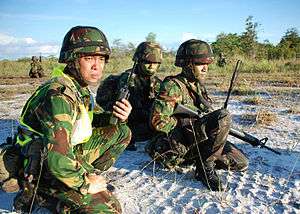
The Royal Brunei Land Forces (RBLF) is under the command of Brigadier General Dato Seri Pahlawan Awang Khairul Hamed bin Awang Hj Lampoh.[6]
The Royal Brunei Land Forces is organised as four separate battalions:[7]
- First Battalion
- Second Battalion
- Third Battalion
- Support Battalion
First Battalion
The First Battalion was established in 1962; the organisation consisted of the first three intakes undertaking basic military training. At the beginning, the organisation was set up in Segenting Camp, Port Dickson, Malaysia. After the development of Berakas Garrison in 1975, the organisation was then changed to the First Battalion Land Force. Under the command of Colonel J. F. Davis, the force consisted of the various departments, including Markas Company, and five Rifle Companies (A, B, C, D and E).[8]
Second Battalion
The Second Battalion was formed on 2 January 1975 at the Bolkiah Garrison. Before this, the Battalion was comprised Company B and E of the First Battalion under the command of the then Commanding Officer, Lieutenant Colonel A.E. Hibbert. The battalion moved to Tutong Camp on 10 May 1976. Following the formation of the Second Battalion, Pengiran Ratna Indera Lieutenant Colonel Pengiran Dato Setia Ibnu bin Pengiran Datu Penghulu Pengiran Haji Apong was then appointed as the commanding officer in charge.[9]
Third Battalion
The Third Battalion was formed and established on 31 May 1994. The battalion was made up of D Company from the First Battalion and F Company of the Second Battalion and the Command Company from the First and Second Battalion. Major Shahlan bin Hidup was the first appointed Commanding Officer in charge of the Battalion. Previously based in Penanjong Garrison,[10] as of 21 June 2007, the Battalion has relocated to a new camp at Lumut in the Belait District.[11]
Support Battalion
The Support Unit was originally established based on five major units; namely an Armoured Reconnaissance Squadron, a Combat Engineer Squadron, an Air Defence Battery, the Penanjong Workshop and Penanjong Garrison Headquarters. It was reorganised on 2 January 1990, and officially established as the Support Battalion, which comprises three major units; namely, an Armoured Reconnaissance Squadron, a Combat Engineer Squadron and the Company Headquarters Support Battalion.[12]
Equipment
The RBLF uses a mix of imported equipment from various suppliers (mainly British, but French, German, Russian, Indonesian and Ukrainian as well).
Infantry Weapons
| Photo | Model | Type | Calibre | Origin | Notes | |
|---|---|---|---|---|---|---|
| Pistols | ||||||
.jpg) | Browning HP | Pistol | 9×19mm Parabellum | |||
| Assault rifles | ||||||
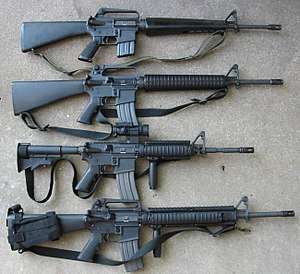 | M16A1/A2/A4 | Assault rifle | 5.56×45mm NATO | Standard infantry rifle. | ||
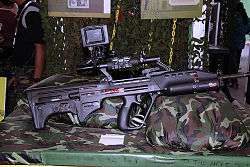 | SAR 21 | |||||
| Semi-automatic rifles | ||||||
| L1A1 Self-Loading Rifle | Semi-automatic rifle | 7.62×51mm | ||||
| Machine guns | ||||||
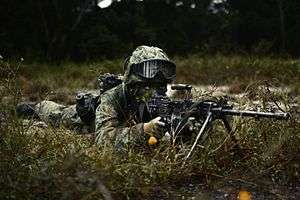 | Ultimax 100 | Light machine gun | 5.56×45mm NATO | |||
 | M2 Browning machine gun | Heavy machine gun | .50 BMG | |||
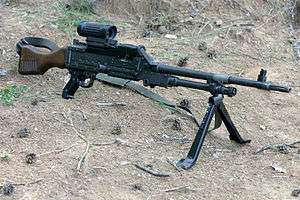 | FN MAG-58 | General purpose machine gun | 7.62×51mm NATO | |||
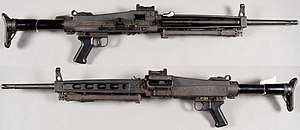 | SIG MG 710-3 | |||||
Grenades, Rockets and MANPADS
| Photo | Model | Type | Quantity | Origin | Notes | |
|---|---|---|---|---|---|---|
| Grenade launchers | ||||||
 | M203 grenade launcher | Underbarrel grenade launcher | ||||
| Anti-Tank | ||||||
| Armbrust | Anti-tank rocket launcher | [13] | ||||
Armoured fighting vehicles
| Photo | Model | Type | Quantity | Origin | Notes | |
|---|---|---|---|---|---|---|
| Tanks | ||||||
 | FV101 Scorpion CVR(T) | Light tank | 16 | 16 upgraded as of 2003[13] | ||
| Armoured Vehicles | ||||||
| VAB | Armoured personnel carrier | 45 | [13] | |||
| Support Vehicles | ||||||
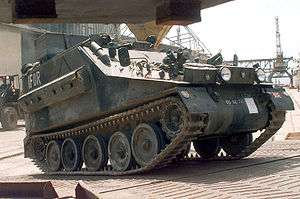 | FV105 Sultan | Armoured command vehicle | 2 | |||
_ARV.jpg) | FV106 Samson | [13] | ||||
Artillery
| Photo | Model | Type | Quantity | Origin | Notes | |
|---|---|---|---|---|---|---|
| Howitzers | ||||||
| L118 | 105 mm towed howitzer | 6 | [14] | |||
| Mortars | ||||||
| L16 Mortar | 81 mm mortar | 24 | [13] | |||
Utility and logistical vehicles
| Photo | Model | Type | Quantity | Origin | Notes | |
|---|---|---|---|---|---|---|
| Utility vehicles | ||||||
| Land Rover Defender | Military light utility vehicle | Unknown | ||||
| Logistical vehicles | ||||||
| Mercedes-Benz Actros | Tractor Unit | Unknown | ||||
| Iveco Eurocargo | Truck | Unknown | ||||
Future Equipment
There are reports that Brunei is or was interested in Indonesian APC's to replace the VAB APC[15]
Brunei has also shown interest in Russian equipment including:[16][17]
International Ties
United Kingdom
The Royal Brunei Land Forces has significant ties to the British Army, due in no small part to the fact that there is a permanent British garrison in Brunei. Following the Brunei Revolt in 1962, an agreement was signed between Brunei and the United Kingdom that a battalion of Gurkhas would be stationed in the country to protect various British interests, most notably the major oil installations at Seria. The current garrison consists of a battalion of the Royal Gurkha Rifles, plus a flight of helicopters from the Army Air Corps in support. However, Brunei is also used by the British Army in general for training in jungle warfare. The presence of one of the British Army's few significant overseas garrisons provides an opportunity to assist the RBLF in its training.
Other Nations
The RBLF maintains close ties with many other nations, both in the South-East Asia region and elsewhere. The RBLF conducts exercises with the Malaysian Army[18] and the Singapore Army[19] on a regular basis. The RBLF has also conducted regular exercises with the armies of both Australia, China, New Zealand, Philippines and Thailand,[20] while the United States Marine Corps conducts annual Cooperation Afloat Readiness and Training (CARAT) in Brunei.[21]
Alliances
References
- ↑ Roles Page 1 Royal Brunei Land Forces Archived 5 July 2007 at the Wayback Machine. - Retrieved 23 April 2007
- ↑ Roles Page 3 Royal Brunei Land Forces Archived 5 July 2007 at the Wayback Machine. - Retrieved 23 April 2007
- ↑ History Page 1 Royal Brunei Land Forces Archived 20 February 2007 at the Wayback Machine. - Retrieved 23 April 2007
- 1 2 History Page 2 Royal Brunei Land Forces Archived 25 August 2007 at the Wayback Machine. - Retrieved 23 April 2007
- ↑ History Page 5 Royal Brunei Land Forces Archived 27 September 2007 at the Wayback Machine. - Retrieved 23 April 2007
- ↑ http://rblf.mindef.gov.bn/Site%20Pages/COMMANDER%20ROYAL%20BRUNEI%20LAND%20FORCE.aspx. Missing or empty
|title=(help) - ↑ Page 1 Organisation Royal Brunei Land Force Archived 27 September 2007 at the Wayback Machine. - Retrieved 23 April 2007
- ↑ Page 2 Organisation Royal Brunei Land Force Archived 22 February 2007 at the Wayback Machine. - Retrieved 23 April 2007
- ↑ Page 3 Organisation Royal Brunei Land Force Archived 27 September 2007 at the Wayback Machine. - Retrieved 23 April 2007
- ↑ Page 4 Organisation Royal Brunei Land Force Archived 27 September 2007 at the Wayback Machine. - Retrieved 23 April 2007
- ↑ New Lumut Camp Celebrates Nisfu Syaaban Archived 29 September 2011 at the Wayback Machine. - Retrieved 18 February 2009
- ↑ Page 5 Organisation Royal Brunei Land Force Archived 27 September 2007 at the Wayback Machine. - Retrieved 23 April 2007
- 1 2 3 4 5 IISS (2012), p. 231
- ↑ "British Army - Artillery - 105mm Light Gun - Armed Forces - a6a6". www.armedforces.co.uk.
- ↑ "Brunei to purchase RI-made APCs". Archived from the original on 14 July 2015.
- ↑ Administrator. "Brunei shows interest for Russian-made air defence missile systems and upgraded tanks T-90MS 2004122". www.armyrecognition.com.
- ↑ "The Global Intelligence Files - [OS] RUSSIA/BRUNEI/MIL - Sultan of Brunei interested in the "flying tank"". wikileaks.org. horizontal tab character in
|title=at position 101 (help) - ↑ Bilateral Page 2 Archived 20 February 2007 at the Wayback Machine. - Retrieved 23 April 2007
- ↑ Bilateral Page 3 Archived 23 February 2007 at the Wayback Machine. - Retrieved 23 April 2007
- ↑ Bilateral Page 1 Archived 23 February 2007 at the Wayback Machine. - Retrieved 23 April 2007
- ↑ Bilateral Page 8 Archived 27 September 2007 at the Wayback Machine. - Retrieved 23 April 2007
Works cited
External links
| Wikimedia Commons has media related to Army of Brunei. |
.svg.png)